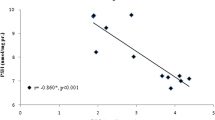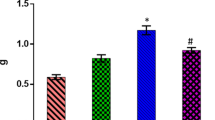Abstract
Background and aims: Acute hypoxia is a threatening clinical case of emergency and may result in ultrastructural damage, with complete loss of cellular and organ functions. However, little is known about the differences in hypoxia tolerance between young and old myocardia and the protective effects of radical scavenging agents in acute hypoxic stress situations. Methods: We investigated the age-dependent differences of the myocardial ultrastructure and antioxidative status (superoxide-dismutase (SOD) activity and malondialdehyde (MDA) content) of young (6 months) and old (22–24 months) Wistar rats (Crl (Wi)Br) after acute respiratory hypoxia of 20 min at 5% v/v O2 in N2O mixture, and the protective effect of Ginkgo biloba extract (EGb 761). Results: Ultrastructural-morphometric and biochemical age analysis only revealed a decrease in the sarcoplasma volume fraction, an increase in homogeneous intramitochondrial areas, significant higher SOD activity and lower MDA levels in the group of old rats. Pretreatment with EGb 761 led to a significant decrease in MDA content in both control groups. Acute hypoxic stress increased the volume fractions of sarcoplasmatic reticulum, t-tubules, vacuoles, and lipid droplets, and caused mitochondrial swelling, with a more significant increase in degenerated and homogeneous intramitochondrial areas in the old group. SOD activity decreased only in the old hypoxic group; MDA content fell in both. Pretreatment with EGb 761 reduced ultrastructural-morphometric hypoxic damage in both groups, significantly below the levels of control. Young rat myocardium showed significantly higher SOD activity after hypoxia than untreated or older specimens. Conclusions: Better hypoxia tolerance is demonstrated by the young myocardium, and an obvious hypoxia-protective effect of EGb 761 in both age groups.
Similar content being viewed by others
References
Lakatta EG, Sollott SJ. Perspectives on mammalian cardiovascular ageing: humans to molecules. Comp Biochem Physiol A Mol Integr Physiol 2002; 132: 699–721.
Abete P, Napoli C, Santoro C et al. Age-related decrease in cardiac tolerance to oxidative stress. J Mol Cell Cardiol 1999; 31: 227–36.
Liu P, Xu B, Cavalieri TA, Hock CE. Attenuation of antioxidative capacity enhances reperfusion injury in aged rat myocardium after MI/R. Am J Physiol Heart Circ Physiol 2004; 287: 2719–27.
Powers SK, Qunindry J, Hamilton K. Aging, exercise, and cardioprotection. Ann NY Acad Sci 2004; 1019: 462–70.
Judge S, Jang YM, Smith A, Hagen T, Leeuwenburgh C. Age-associated increase in oxidative stress and antioxidant enzyme activities in cardiac interfibrillar mitochondria: implications for the mitochondrial theory of aging. FASEB J 2005; 19: 419–21.
Muscari C, Giaccari A, Giordano E et al. Role of reactive oxygen species in cardiovascular aging. Mol Cell Biochem 1996; 160/161: 159–66.
Rodriguez C, Mayo JC, Sainz RM et al. Regulation of antioxidative enzymes: a significant role for melatonin. J Pineal Res 2004; 36: 1–9.
Navarro-Arevalo A, Canavate C, Sanchez-del-Pino MJ. Myocardial and skeletal muscle aging and changes in oxidative stress in relationship to rigorous exercise training. Mech Ageing Dev 1999; 17: 108.
Bejma J, Ramires P, Ji LL. Free radical generation and oxidative stress with ageing and exercise: differential effects in the myocardium and liver. Acta Physiol Scand 2000; 169: 343–51.
Sohal RS, Weindrich R. Oxidative stress, caloric restriction and aging. Science 1996; 273: 59–63.
Genova ML, Pich MM, Bernacchia A et al. The mitochondrial production of reactive oxygen species in relation to aging and pathology. Ann NY Acad Sci 2004; 1011: 86–100.
Sastre J, Pallardo FV, Garcia de la Asuncion J, Vina J. Mitochondria, oxidative stress and aging. Free Rad Res 2000; 32: 189–98.
Miquel J, Fleming JE. Theoretical and experimental support for an “oxygen radical-mitochondrial injury” hypothesis of cell aging. In Johnson JE, Walford R, Harman D, Miquel J, eds. Free Radicals, Aging, and Degenerative Diseases. New York: Liss, 1986: 51–7.
Flohe L, Otting F. Superoxide dismutase assays. Methods Enzymol 1984; 105: 93–104.
Uchiyama M, Mihara M. Determination of malonaldehyde precursor in tissues by thiobarbituric acid test. Anal Biochem 1978; 86: 217–21.
Burton K. A study of the conditions and mechanism of the diphenylamine reaction for the colorimetric estimation of deoxyribonucleic acid. Biochem J 1956; 62: 315–23.
Dröge W. Free radicals in the pysiological control of cell function. Physiol Rev 2001; 82: 47–95.
Martin R, Fitzl G, Mozet C et al. Can antioxidants influence the lifespan? In Sames K, Sethe S, Stolzing A, eds. Extending the Lifespan Medizin und Gesellschaft, LIT-Verlag Münster 2005; 12: 107–15.
Sohal RS, Sohal BH, Brunk UT. Relationship between antioxidant defense and longevity in different mammalian species. Mech Ageing Dev 1990; 53: 217–27.
Singh N, Dhalla AK, Seneviratne C, Singal P. Oxidative stress and heart failure. Mol Cell Biochem 1995; 147: 77–81.
Nakanishi K, Tajima F, Nakamura A et al. Effects of hypobaric hypoxia on antioxidant enzymes in rats. J Physiol 1995; 489: 869–76.
Kübler W. Proceedings: Disorders of the myocardial metabolism in coronary disease. Med Klin 1975; 70: 1012.
Di Lisa F, Bernardi P. Mitochondrial function as a determinant of recovery or death in cell response to injury. Mol Cell Biochem 1998; 184: 379–91.
Piper HM, Siegmund B, Ladilov YV, Schlüter KD. Calcium and sodium control in hypoxic-reoxygenated cardiomyocytes. Basic Res Cardiol 1993; 88: 471–82.
Frenzel H, Feimann J. Age-dependent structural changes in the myocardium of rats. Mech Ageing Dev 1984; 27: 29–41.
David H, Bozner A, Meyer R, Wassilew G. Pre- and postnatal development and ageing of the heart. Ultrastructural results and quantitative data. Exp Pathol Suppl 1981; 7: 1–176.
Schmucker DL, Sachs HG. Age-dependent alterations in rat ventricular myocardium: a quantitative analysis. Mech Ageing Dev 1985; 31: 89–101.
Schaper J, Schwarz H, Kittstein G. The effects of global ischaemia and reperfusion on human myocardium: quantitative evaluation by electron microscopy. Ann Thorac Surg 1982; 33: 155–22.
Saija A, Scalese M, Lanza M, Marzullo D, Bonina F, Castelli F. Flavonoids as antioxidant agents: Importance of their interaction with biomembranes. Free Rad Biol Med 1995; 19: 481–6.
Fitzl G, Welt K, Schaffranietz L. Myocardium-protective effects of Ginkgo biloba extract (EGb 761) in old rats against acute isobaric hypoxia. An electron microscopic morphometric study. Exp Toxic Pathol 1996; 48: 33–9.
Fitzl G, Welt K, Martin R et al. The influence of hypoxia on the myocardium of experimentally diabetic rats with and without protection by Gingko biloba extract. Exp Toxic Pathol 2000; 52: 419–30.
Schneider R, Welt K, Aust W, Löster H, Fitzl G. Cardiac ischemia and reperfusion in spontaneously diabetic rats with and without application of EGb 761: I. Cardiomyocytes. Histol Histopathol 2008; 23: 807–11.
Jezova D, Duncko R, Lassanova M, Kriska M, Moncek F. Reduction of rise in blood pressure and cortisol release during stress by Ginkgo biloba extract (EGb 761) in healthy volunteers. J Physiol Pharmacol 2002; 53: 337–48.
Fukai T, Siegfried MR, Ushio-Fukai M, Cheng Yiang, Kojda G, Harrison DG. Regulation of vascular extracellular superoxide dismutase by nitric oxide and exercise training. J Clin Invest 2000; 105: 1631–9.
Muller B, Weschyov AL, Gyorgy K, Stoclet JC. Inducible NO synthase activity in blood vessels and heart: new insight into cell origin and consequences. Physiol Res 2000; 49: 19–26.
Braquet P, Paubert-Braquet M, Koltai M, Bourgain R, Bussolino F. Is there a cause for PAF antagonists in the treatment of ischemic states? Trends Pharmacol Sci 1989; 10: 23–30.
Author information
Authors and Affiliations
Corresponding author
Rights and permissions
About this article
Cite this article
Mozet, C., Martin, R., Welt, K. et al. Cardioprotective effect of EGb 761 on myocardial ultrastructure of young and old rat heart and antioxidant status during acute hypoxia. Aging Clin Exp Res 21, 14–21 (2009). https://doi.org/10.1007/BF03324893
Received:
Accepted:
Published:
Issue Date:
DOI: https://doi.org/10.1007/BF03324893




